House Diary: Late Summer Wrap-Up
[Cover photo: A late summer bouquet of zinnia, Maximillian sunflower, marigold, Shasta daisy and sedum brightens the dining table, already set for fall]
It’s been a long, hot summer, but at last the autumn breezes have arrived! Prime time to look back and review the progress the garden has shown this first season on the property.
Over all, I’m very pleased with how things have gone. I actually lost only a single perennial, one of those new ill-fated heliopsis cultivars in orange; everything else either thrived, or held its own. And considering all the plants I plunked into this bit of soil, that’s pretty amazing. Now, the big question is – what liked it enough to return next year? But that’s an answer for next spring – for now, let’s just take an amble down memory lane, horticulture style.
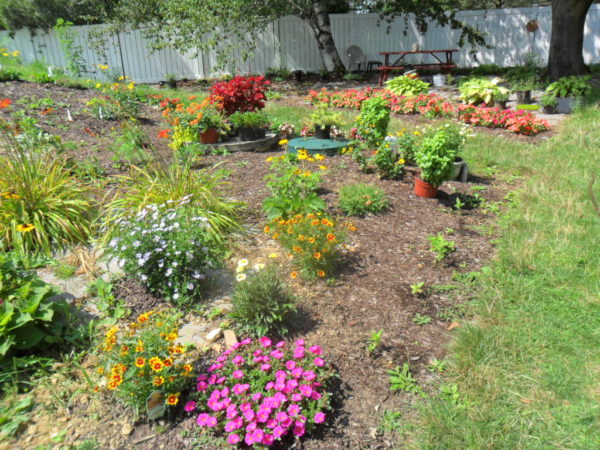
The late August garden is still vibrant with vivid color, as plants have reached maturity and give one final bravura performance before fading away
The major project of the time period was finishing the mulching of the yard. Previously, we had only covered areas that had been planted with bulb or bareroot, plus a ring of mulch about perennials as they were inserted, leaving the rest of the yard covered in grey weed barrier fabric, a less-than-natural look and feel for the garden. The contractor kept putting off the job, but finally in late August came through, and the 20 cubic yards he dropped and spread have finally brought the garden into a unified whole.
But my main task for the late summer was finding and positioning shrubs and trees for the garden. I had tackled the first waves of bulbs last fall (installing 500 then, with another 800 to follow this year), and the main outlines of the perennial plantings this spring and summer, but as August waned it was time to think about fall plantings, and where I needed to up my shrub game.

Mulching brought the landscape together, creating a seamless whole of the patchwork plantings sporadically inserted over the long growing season
Shrubs and trees form an important part of the garden – its “bones” as it were. Unlike the ephemeral springtime bulb, the transient annuals, and even the hardy perennials, which die back into the soil at the end of the season, shrubs and trees are omnipresent, a vivid reminder, even in deepest winter, that this is a space dedicated to green, however brown it may appear. So choosing shrubs and trees with seasonal interest is important, extending the beauty of the garden up and overhead, beyond the planting beds, and past the growing season. Shrubs in particular can create low-level screens, important for privacy and light level control, or mask unattractive features such as air conditioning units, electric meters, and the like. They can transform an essentially flat space into a 3-D panorama.
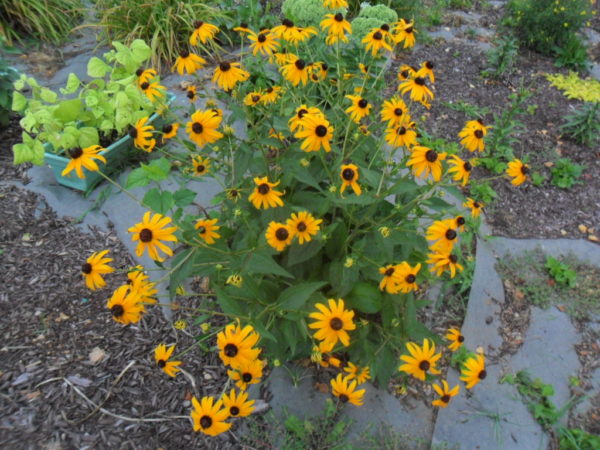
Released from its confining pot, this decades-old clump of rudbeckia, or brown-eyed Susan, really took off after I brought it from Philadelphia and transplanted it into the soil here
The main issue I see going forward is the age of the existing tees on the property. The “baby” of the group will be 50 next spring! The birches, in particular, seem to be slowly failing, and as they are the umbrellas for my shade gardens, I needed to do something to shore up that area, or risk losing the new shade perennials I had spent so much time and money installing.
As the maple and paper birch grew together over the years, they formed a natural arch, with a high canopy between them that is the enemy of shade, as the sunlight slips beneath it for far too long each day. I decided to fill that space, both east and west, with a native dogwood, cornus alternifolia, AKA Pagoda Dogwood. Don’t let the image below fool you – mine are just two feet tall! But in time, they’ll look like this:
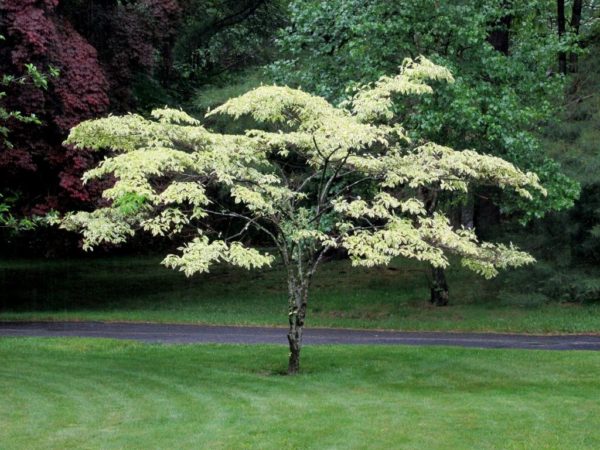
A mature cornus alternifolia, or Pagoda dogwood; mine have quite a few seasons before they reach this size, but are off to a good start
My cornus may be small, but they are mighty, and already showing lovely fall color, another factor that drew me to them (with the suggestion coming from a Master Gardener friend of mine, who has been incredibly helpful in planning this stage). On the western end of my unintended cathedral ceiling of foliage, I also planted a Star Magnolia, another attractive spring bloomer, a bit off the line and closer to the fence. I was surprised to see the flower buds emerge in August, and even more surprised by their pussy willow-like appearance, resembling grey wooly caterpillars clustered at junctures of leaves and twigs with main branches (I actually googled these when they first appeared, concerned it might be some sort of parasitic growth). I’ve enjoyed others’ Star Magnolias for years, but never had one up close before, so to speak, and am looking forward to the experience.
In time, these will grow to augment, and perhaps eventually replace, the old trees. But I still had the problem of the lower levels, where sunlight slants beneath the canopy for much longer than my shade plants find comfy. For that, I needed to develop a screen, not of mesh and metal, but of green.

The fuzzy-wuzzy flower buds of the Star Magnolia look like so many caterpillars cozied up to clefts and crotches in branches, ready for their long winter’s nap
I’ve always loved holly and winterberry, and had planned a row of these just inside the gate to the east, a shaw of evergreen ambassadors to welcome visitors to the garden even on the snowiest of winter days. But as I looked at the size of mature hollies, I realized a full row was not possible in that space without crowding them too closely. So I kept the two traditional green hollies there for my cheery entrance, added a variegated green-and-yellow boxwood to the mix, and decided to move the winterberries under the birch.
Winterberry is, to my mind, one of the loveliest winter shrubs. It’s essentially a deciduous holly, dropping its leaves in late autumn, allowing the bright red berries to blaze starkly from its pale grey-brown stems. But it’s not self-pollinating, as many hollies are, so it needs a male for those ruby pearls. And the males, alas, as so often in life, are rather cumbersome and unattractive, so unlike their sylph-like female counterparts. However, they are dense (also a common male feature in humanity, if you think about it), which makes them perfect for my shade-producing needs.

My diminutive Red Sprite winterberry infants are already thick with berries, blushing vivid red as autumn approaches; they’ll make a stunning winter contrast to snowy backdrops, if the birds leave me any to enjoy
There is a point where the pendulous eastern branches of the paper birch come close to sweeping the ground as the western edge of the sand mound rises to meet them, and that is where I chose to plant my line of winterberries. I had several options, but landed on Red Sprite, which as the name implies, is a rather diminutive form. But that was ideal for this space: at about five feet tall at maturity, they will just scrape the lowest limbs of the birch, and further, will allow me to plant a second line of shade defense behind them, deeper under the birch canopy.
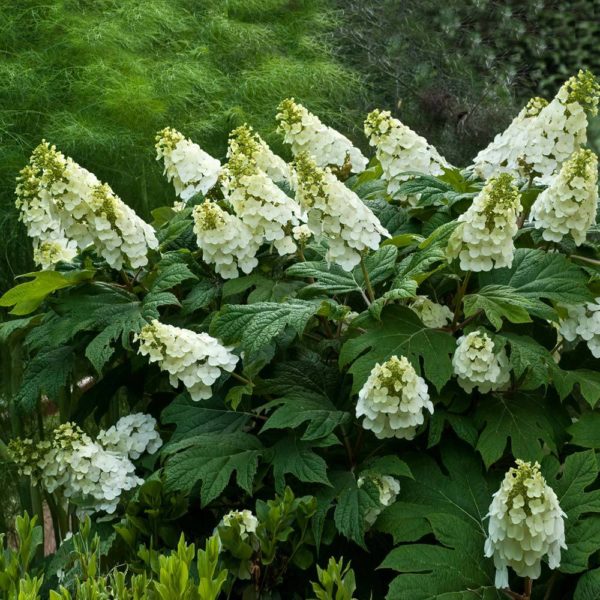
A mature Alice oakleaf hydrangea, loaded with elongated white blossoms, will provide cover for tender shady perennials behind it
For this, I chose hydrangea. There is incredible variety in the hydrangea world these days, and these are not your granny’s foundation plantings, four feet tall and clustered with pink or blue softball-sized blossoms. No, these are massive specimens (or will be in time), eight feet by eight feet at maturity, with huge white, elongated blooms, and robust red fall color to boot!
Mine were too small to flower this year, but already I see hints of their autumn tones emerging. I bought four to start, mixed varieties, from Alice to Annabelle, Pee-Wee and Snowflake. Two I placed behind the winterberries in the east, the other two in the west near the Star Magnolia. Along with another new favorite, they should provide enough SPF-30 for a bevy of shade-lovers!
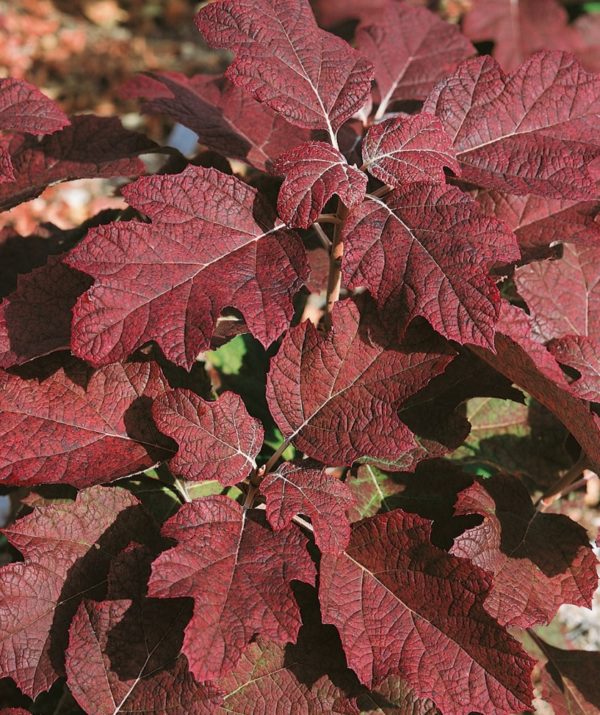
Pee Wee hydrangea flashes its showy fall colors, adding an additional season of interest to the plant
The new friend I mentioned above is aronia, commonly known as chokeberry. There are two basic types, one with red berries (brilliantissima is the cultivar I plumped for), one with black (I chose Viking). The birds love them, and I selected one of each for additional color interest. Again, mine are too small to flower and fruit, but as with hydrangea, vibrant fall color is another selling point. Hydrangea tend toward red or burgundy foliage, whereas chokeberry inclines to the orange and yellow. Together they’ll put on a quite a show flanking the maple, with its bright yellow leaves above.
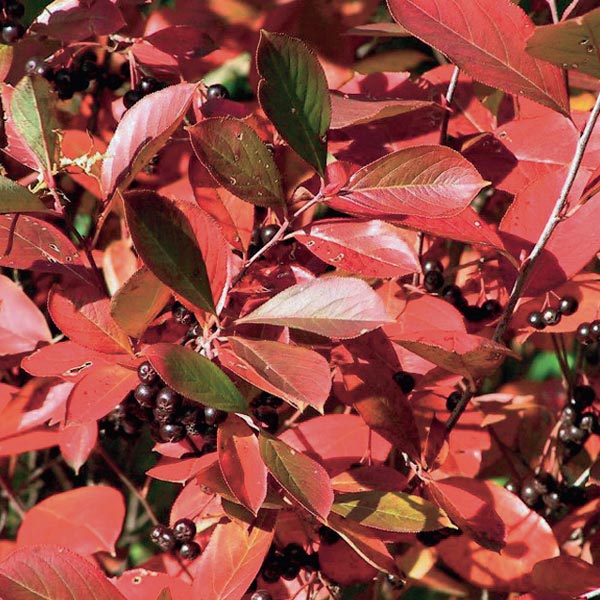
Viking, a variety of black chokeberry, vies with other contenders for “best in show” in the fall color category
Late August or early September is an excellent time to update a garden notebook, recording what worked best and what lagged behind. An outstanding late summer bloomer is Maximillian sunflower, a rare perennial variety that grows to a height of 5-6 feet annually and is profusely covered in medium yellow, daisy-like blooms. A favorite with pollinators, this plant provides garden “buzz” in more ways than one, and has actually attracted a few honeybees to the yard, a species that essentially disappeared from here more than a decade ago.

The massive Maximillian sunflower is a vision of loveliness, albeit Hurricane Isaias knocked it akimbo, and I neglected to stake it; when erect, it’s almost five feet tall, but dies back to the ground each autumn
My long-awaited crocosmia came into flower in late August as well. So far, the blooms are sparse, but the plants seem vigorous, so I’m hoping for a better flowering next season. These were bareroot mail order items, which came in very late in the spring, likely limiting their growth this year.
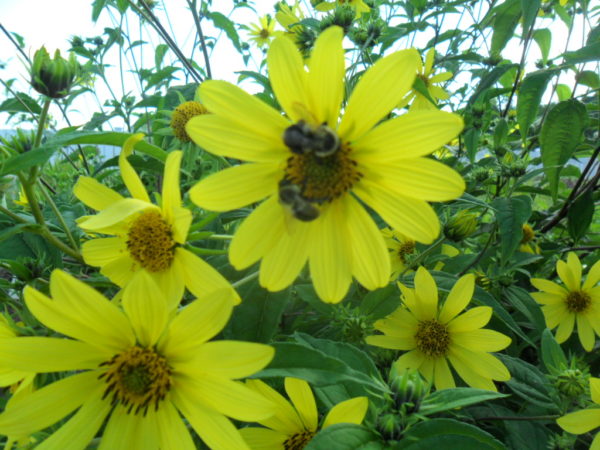
Standing room only! A pair of bumblebees vie for the choicest pollens on a single blossom of the Maximillian sunflower
Another late-comer, totally my fault, was the annual seedlings I sowed to fill in the large bulb fields on the sand mound, once their leaves had melted away in the summer heat. Ideally these would have been put out in early to mid-May, but I had a few others things on my mind at that time, being in the midst of the final move, and they were neglected. It was late June before I came across the seed packets again, and knew I was facing a time crunch, but determined to try them anyway, and I’m glad I did.
I planted with the Moon, choosing a waxing Moon in an Earth or Water Sign for their sowing, which delayed the task a bit longer. But by early July everything had been sown, and my germination rates seemed to confirm that waiting on Luna’s good timing is indeed an effective way to boost yield.
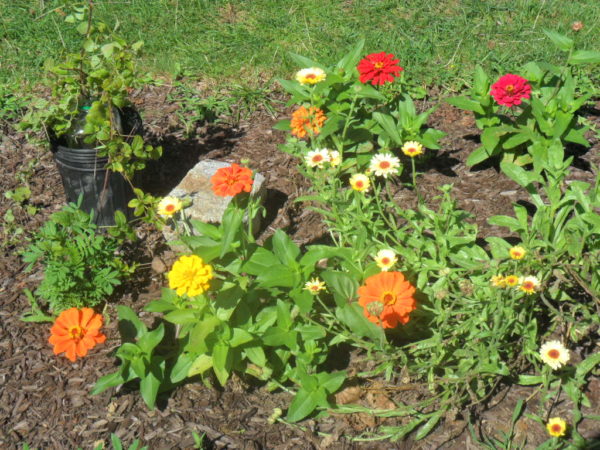
Although sown late, the zinnias are coming into their own, and should have about two months of bloom in them if a killing frost doesn’t arrive ahead of schedule
I sowed zinnia, cosmos and marigold in old plastic trays from garden centers, pierced for drainage, but lined with newspaper to hold the soil. I wasn’t sure how well they’d germinate if direct-sowed into the mulch, so opted for the more cumbersome, labor-intensive transplant method. By late July they were ready to move into the garden proper, and about a month later the zinnias began to bloom.

An electric orange nasturtium fairly vibrates with color; the flowers are edible, with a slight peppery taste
I had placed them in a line on each side of the lower path, atop the small spring bulbs slumbering beneath. Incredibly, although they weren’t even budded at transplant, they came in just the way I would have wanted them, with no two successive plants of the same color! There they stand, in tones of white, yellow, orange, pink and red, growing large and bushy enough now to take a few discreet cuttings for indoor bouquets, without marring the outside show.
The marigolds have just started to open, but are filled with buds that promise autumnal splendor, with their tones of gold and rust. The cosmos are HUGE, and way too closely planted, as it turns out, but so far no sign of bud, as they careen toward a killing frost. Hopefully they’ll win the race and give me some showy blossoms in pink, burgundy and white before the cold takes them. Regardless, their height and airy, ferny foliage is a welcome change of pace from the usual leaf textures of most perennials I have.
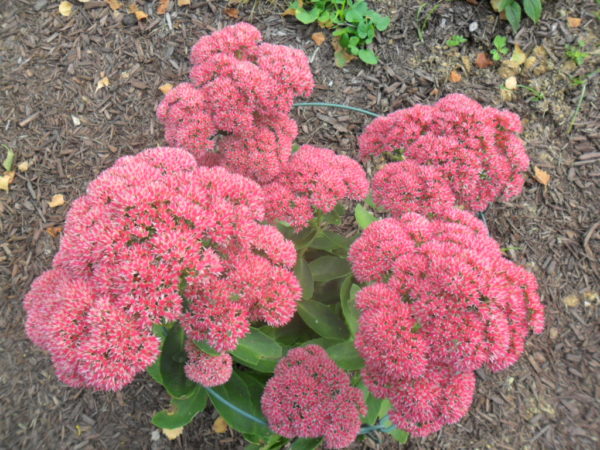
Braiiiins! You’d have to be a zombie not to appreciate sedum “Autumn Joy” as it lights up the early fall landscape
Another late bloomer I have come to love is sedum, specially the Autumn Joy cultivar. These seemed to remain in bud forever, but have finally opened their massive flat clusters of teeny florets to reveal enchanting tones of pink. One of my pair is paler than the other, but both are stunning, looking almost like exposed brains, or some sort of floral scrubbing sponge.
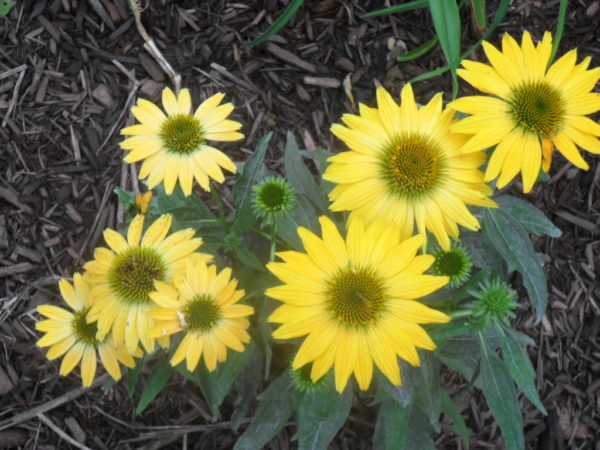
Yes, the garden already has a lot of yellow, but I couldn’t resist this new strain of echinacea, so buttery and cheerful
As we moved into mid-September, it was time to think about chrysanthemums. Fortunately I have an excellent outlet for these, with prime, large plants, Lancaster-grown, available for just $6. I’ll likely purchase 15 in total, but I am staggering their acquisition so they won’t all bloom at once.
I bought five initially, two rust-red, two deep orange, and one purple, which I placed on the new bed at the top of the sand mound. These are also perennial, and will be dug into the soil eventually, but for now they remain in their pots. Placing these gave me the fall itch in spades, so I drug out my collection of 18 outdoor faux pumpkins and strewed the bed with them. “Pumpkin Hill”, as I now term it, will be the site of Halloween’s graveyard next month, but I’ve also indulged in a sneak preview now with a set of new solar-powered jack-o-lanterns in white and orange, purchased at Christmas Tree Shops.
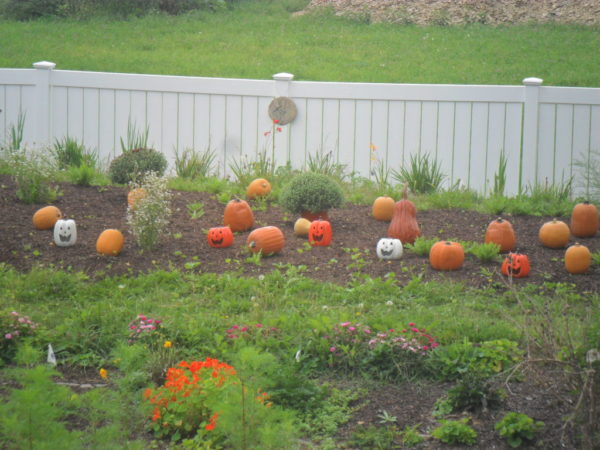
“Pumpkin Hill” in all its glory; these pumpkins so far are all counterfeit, but will be joined by live specimens in due course
I mean, no sense packing them up for a few weeks, right? So from the car trunk to the garden, out they went! They are wonderfully eerie, with orange lights instead of white, and they burn all night long, still shining brightly when I go to feed the outside cats at 5:30 AM.

My “dinner plate” portulaca grew big as a turkey platter this year, amping up the color with electric pink islands in the sand (mound)
Other superlative performers this year were the perennial blue daisy, with virtually no bloomless “down time” whatever; the “dinner plate” portulaca, which grew big as a platter and drew the eye with its electric pink blossoms; and the impatiens, in tones of lavender, pink and coral. These had been planted in too much sun and initially required agonizing amounts of water to keep alive, but it paid off in the end with a lush line of intermingled colors along the southward path.
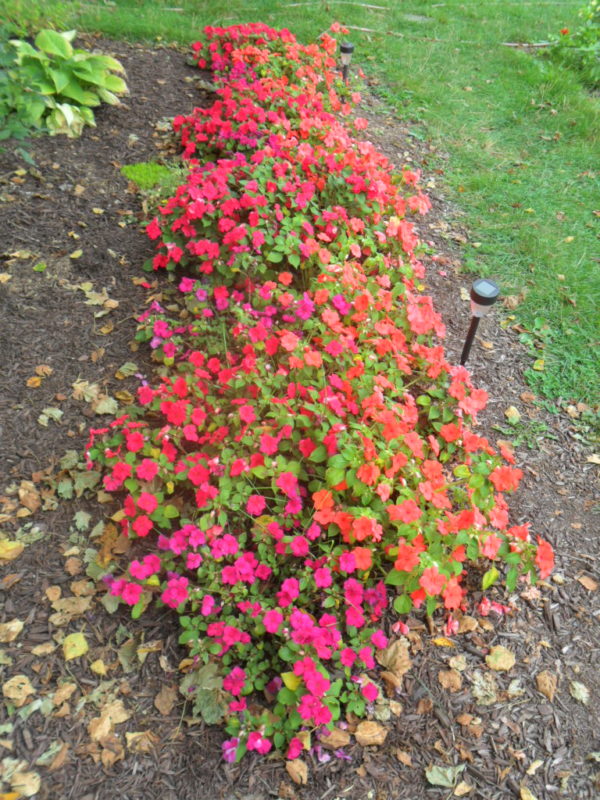
A riot of color, the impatiens bed took a lot of water to keep it alive in its infancy, but the payoff is easy to see as it comes into its own
The echinacea also thrived, in shades of white, yellow, pale and deep pink (termed “purple”), orange and my new favorite, “Cheyenne Spirit”, which emerges orange-pink, blushes to raspberry, and then fades to mauve. I acquired another two dozen daylilies late in August, making for about four dozen total, in a dizzying variety of color and form. These had already bloomed for the season, but the stock, from nearby House of Lilies, was exceptionally large and robust, assuring that next year’s display will be a memorable one.

Cheyenne Spirit echinacea shines brightly from the perennial bed on the sand mound; its voluminous blooms go through multiple transformations of tone before fading to dark mauve
As a whole, I think it was a year well-spent, a seed planted, if you will, that should reap a bountiful harvest in the seasons ahead.

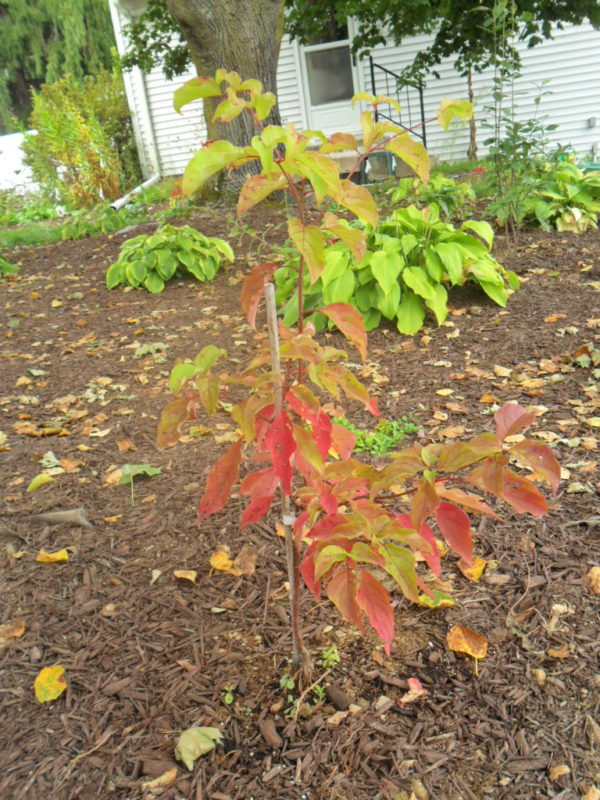

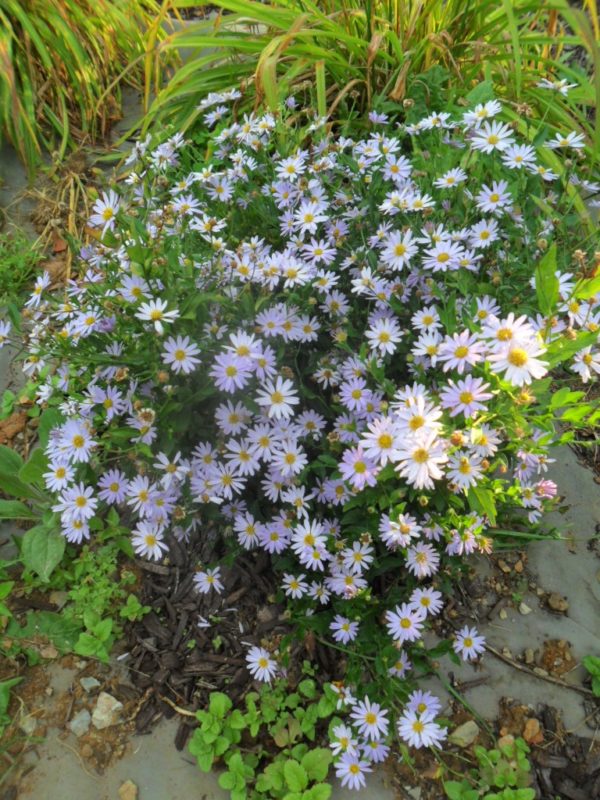

2 comments, add yours.
Alexa
Thank you Alex! I learned some things. The colors are amazing. Great visual display and I’m glad the pollinators came back.
Morris Bodnar
Hi Alexis, beautiful garden…..you have all those flowers?
I have another BIDEN asteroid for you……it’s BIDELMAN….works good
in my charts so far.